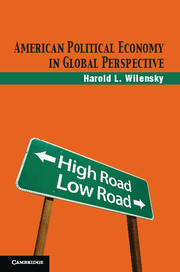Book contents
- Frontmatter
- Contents
- Figures
- Tables
- Preface and Introduction
- Acknowledgments
- Part I Globalization, Public Policy, and the Well-Being of People
- 1 The Welfare State as the Center of Public Finance and Political Conflict
- 2 Energy Policy and Performance
- 3 What Trade-Offs Are Good and Bad for the Economy?
- 4 Retrenchment of the Welfare State?
- 5 Pensions Converge, U.S. Health Care Remains Unique
- 6 The Impact of “Globalization”
- Part II Moving the United States Off the Low Road
- Appendix
- Notes
- Bibliography
- Index
3 - What Trade-Offs Are Good and Bad for the Economy?
Domestic Structures and Policies That Permit Adaptation to Globalization
Published online by Cambridge University Press: 05 June 2012
- Frontmatter
- Contents
- Figures
- Tables
- Preface and Introduction
- Acknowledgments
- Part I Globalization, Public Policy, and the Well-Being of People
- 1 The Welfare State as the Center of Public Finance and Political Conflict
- 2 Energy Policy and Performance
- 3 What Trade-Offs Are Good and Bad for the Economy?
- 4 Retrenchment of the Welfare State?
- 5 Pensions Converge, U.S. Health Care Remains Unique
- 6 The Impact of “Globalization”
- Part II Moving the United States Off the Low Road
- Appendix
- Notes
- Bibliography
- Index
Summary
As we have seen in our discussion of national variations in the welfare state and equality, as well as differences in energy policy and performance, types of political economy shape national responses to common global challenges, such as oil shocks and environmental degradation. These national variations can also provide an answer to the puzzle that corporatist big spenders on average have done better or as well as the fragmented decentralized lean spenders in economic performance; they have also flexibly adapted to external shocks (see Tables 3 and 4). The puzzle is solved by the trade-offs facilitated by both social spending and the national bargaining patterns institutionalized in the more consensual democracies.
Figure 2 shows the causal model I used for regression analysis of economic performance. It singles out one of the three types of bargaining arrangements among major economic and political actors without reference to the five types in Table 1, using numerical scores instead. The inverse of the policies and outcomes in Figure 1 are typical of the confrontational systems of the fragmented and decentralized political economies.
- Type
- Chapter
- Information
- American Political Economy in Global Perspective , pp. 42 - 55Publisher: Cambridge University PressPrint publication year: 2012



